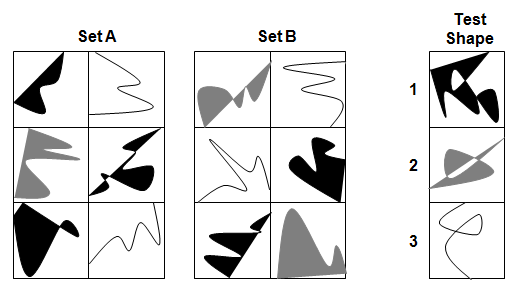UKCAT Unusual Abstract Test Patterns
One of the top 10 key questions to become familiar with for UKCAT abstract reasoning test are questions that consist of unusual looking shapes. Often patterns in these questions are presented in variety of forms with unusual looking symbols, squiggles or waves. It is no secret that these patterns can make the question to look difficult. The below text presents example question that was extracted from UKCAT abstract reasoning test and gives you tips as what to look for. If you wish to review tutorial on other top key questions then refer to section on common abstract reasoning patterns.
For the following consider the test question below. Note that your task is to find the relationship of set A and set B and then answer whether the test shape fits into set A, set B or neither. To give you a tip before you start, look at two sets first to figure out the pattern before you look at the test shapes otherwise you may get confused. Give yourself 60 seconds to see whether you can get the answer right. You may start working now.
 |
Determine whether the test shapes belong to set A, set B or neither.
The above abstract sets present with rather unusual looking squiggles which may scare off number of test takers. If you haven’t found the relationship between boxes don’t be discouraged your test taking strategy will improve with practice.
Note that if you examine the above sets carefully you will find that you can rule out that squiggles differentiate from each other by their colour. The colour serves here only as a distractor. If you take harder look you may further notice that squiggles in set A are touching the top and the right edge of the box whereas the squiggles in Set B are touching the left and bottom of the edge in each box. Thus, you can conclude that test shape 1 must belong to set A as it touches the top and right edge whereas test shape 2 and 3 belong to neither set as neither of them follow pattern of set A nor set B.
In UKCAT abstract reasoning tests you may find number of set questions that contain unusual looking patterns. The first step to find the pattern is not to panic but rather focus your efforts and approach the test question in methodical way. You can review abstract reasoning practice tips to see how to search for vital clues to work out patterns in these assessments.
At last, unusually looking patterns in UKCAT abstract reasoning tests may seem to be difficult but if you examine them carefully they would be easy to figure out. Once you will start practicing these your eyes will be trained to uncover hidden patterns and you will be half way through to uncovering the pattern. Remember, practice makes perfect. Attempt to practice as many questions as possible so that you can recognise patterns instantly. Good luck with your test preparation.

